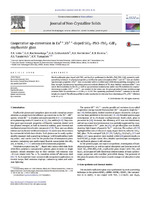| dc.description.abstract | Novel oxy fluoride glass doped with YbF3 and Eu2O3 is synthesized in the SiO2–PbO–PbF2–CdF2 system by melt quenching technique. Its physical properties, as well as the optical absorption of Eu3+ and Yb3+ ions are studied. Spectroscopic properties of Eu3+ ions are modeled within modified Judd–Ofelt theory, yielding absorption oscillator strength, luminescence branching ratios and radiative lifetime of 5D0 state. Intrinsic emission of Eu3+ ions under direct excitation in the UV, as well as up-conversion luminescence under near-IR excitation via cooperative energy transfer, 2Yb3+→ Eu3+, are studied. In the latter case, the glass provides intense reddish-orange emission with CIE coordinates x= 0.636, y= 0.363. The asymmetry parameter R for Eu3+ emission in the studied glass is about 8. The efficiency of this transfer mechanism is estimated from shortening of 2F5/2(Yb3+) lifetime to be 10 ± 1%. | en |

